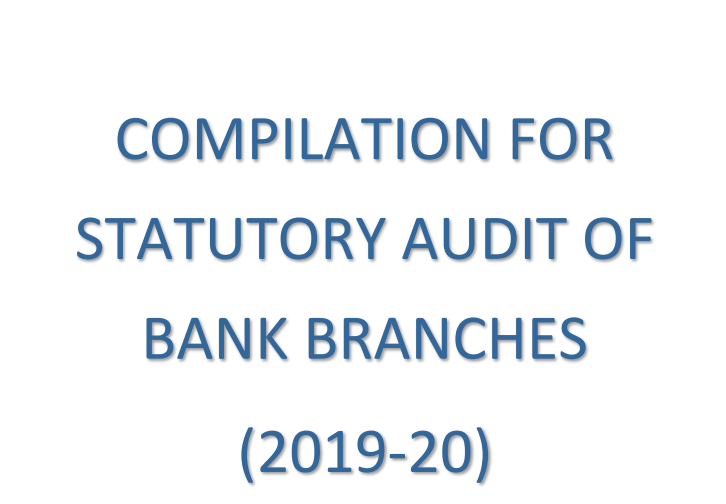Compilation for Statutory Audit of Bank Branches (2019-20)
Compilation for Statutory Audit of Bank Branches (2019-20)
General Information
Branch Audit is a stepping stone to the Final Audit of the Bank which culminates into the generation of Annual Reports.
The Bank’s financial statements are prepared under the historical cost convention, on the accrual basis of accounting ongoing concern basis, unless otherwise stated and conform in all material aspects to Generally Accepted Accounting Principles (GAAP) in India, which comprise applicable statutory provisions, regulatory norms/ guidelines prescribed by the Reserve Bank of India (RBI), Banking Regulation Act, 1949, Accounting Standards issued by the Institute of Chartered
Accountants of India (ICAI), and the practices prevalent in the banking industry in India.
With respect to PSBs and other Private Banks which are listed on stock exchanges, there could be a possibility that the partner and/or his relatives are shareholders of such PSBs and other Private Banks. Care should be taken to dispose of the shares held or take corrective action, as per the code of conduct of the ICAI, SEBI regulations, Companies Act and the firm’s internal policies, prior to acceptance of the Statutory Audit.
APPOINTMENT OF AUDITOR
COMMUNICATION WITH THE PREVIOUS AUDITORS
➢ As per Clause 8 of Part I of the first schedule to the Chartered Accountants Act, 1949, a Chartered Accountant in practice cannot accept the position as auditor previously held by another Chartered Accountant without first communicating with the previous auditor in writing.
➢ Therefore auditor should communicate with the previous auditor in this regard and the mere posting of the letter under the certificate of posting is not sufficient to establish communication with the previous auditor unless there is some evidence to show that the letter has in fact reached the previous auditor.
➢ The incoming auditor should, therefore, communicate with the previous auditor in such a manner as to retain in his/her hands’ positive evidence of the delivery of the communication to the addressee.
➢ In the opinion of the Council of the Institute, communication by a letter sent ‘Registered Acknowledgement Due’ or by hand against a written acknowledgment would in the normal the course provides such evidence.
➢ Further, it is seen, nowadays, that auditors communicate with each other electronically by email and often soft copies are used, it is advisable to ensure that the proof of delivery is obtained and kept in the audit file, however, it is also advisable to subsequently procure the hard copies of the letters and proof of delivery and file the same in the audit files.
ACCEPTANCE OF ENGAGEMENT BY THE AUDITOR
➢ On receipt of the engagement letter from the Head Office of the concerned bank for conducting the Statutory Audit of the specific branches mentioned therein, the Auditor should immediately convey his consent or otherwise to the designated authority mentioned in the engagement letter.
➢ While sending the acceptance letter, care should be taken to forward the necessary documents mentioned in the offer of engagement duly signed by the authorized partner/ proprietor to avoid inconvenience and delay subsequently.
AUDIT PLANNING
AUDIT PLAN
➢ Next comes to Planning and chalking out a suitable strategy to set the scope, nature, timing, extent of resources required for the audit.
➢ The audit plan needs to be discussed with the audit team. In fact, the audit team should be involved from the first day to make them realize their responsibility and their area should be clearly demarcated keeping in view of skill, past experience, and educational qualification.
➢ This audit plan should be properly documented with respect to timing, the extent of checking, audit procedures to be followed at assertion level and should be flexible and updated or changed as and when necessary.
➢ The selection of the engagement team is a key activity in the development and execution of an effective and efficient audit plan.
➢ The assignment of qualified and experienced professionals is an important component of managing engagement risk.
➢ The size and composition of the engagement team would depend on the size, time available to complete the assignment, nature, and complexity of the bank’s operations.
➢ In order to update himself, the auditor can obtain knowledge of the level of operations and the special type of business e.g. Foreign Exchange, Govt. Business, Large Advances, Agriculture Advances, etc. being conducted by the branch by talking directly to the branch manager or the previous auditor.
➢ Discussion with internal/concurrent/other audit personnel regarding the nature, timing, and extent of work done by them and review of their audit reports, especially how issues raised are closed will help the auditor to carve out a suitable audit team.
➢ Thus, this understanding of the business and using this information appropriately assists the auditor in assessing risks and identifying problems, planning and performing the audit effectively and efficiently, evaluating audit evidence, and providing better services to the bank.
➢ The auditor should communicate the concerned Branch Managers freely to assess the stage of preparation of statements by the branch which are required to be examined and signed by the auditor.
PRE-AUDIT PLAN
➢ This can be handed over personally in advance or sent by email so that by the time the audit team reaches the branch, the required files, records and information are ready. It will save time and improve the efficiency and quality of the audit.
➢ Please note that by the time you commence the branch audit, consolidation of all the unaudited returns of branches is already completed at the Head Office level.
➢ Branches are accordingly not allowed to alter any of the branch statements after the EOD is done at the branch as of 31st March. In case any changes are required to be made in the figures, the same may be done through Memorandum of Changes (MOC) only.
➢ If the branch is handling a large portfolio of advances a pre-audit visit is solicited but this should be done only after having discussions with the branch manager.
➢ The Auditor may arrange a preliminary meeting with the Branch Manager of the auditee branch to discuss the plan to complete the audit in time. The meeting should cover:
• Introducing the designated staff members who would be responsible for different auditable areas
• Format of the reports/certificates to be issued by the auditors. Discuss and explain various returns required to be audited.
• Provide the accounting policies of the bank – Designated staff should be provided with the accounting policies and internal circulars issued by the Bank from time to time.
➢ Reconciliation process- The reconciliation process under various accounts head- Suspense account, Interoffice account, bank accounts, etc. should be understood properly to avoid any misunderstandings.
➢ It will be better if a list of items required during the audit is given to the branch manager in this meeting inter-alia containing the following:
• RBI inspection report, Management Audit report, Credit audit report, Branch inspection report, Concurrent audit report, Risk focused internal audit report, LFAR, Statutory Audit Report, and Audited accounts – Last report wherever applicable. Tax Audit Report although not to be audited Branch has to submit the same in time.
Download the copy:
If you already have a premium membership, Sign In.













